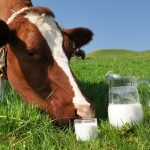
They’re used to these hardships, according to Sjostrom. What they’re not accustomed to is so many piling up in a single season. In most parts of the state, this kind of devastation hasn’t happened “for probably 20 years.”
And it’s not over. Cows, he explains, are “prehistoric” creatures that rely on routine. When milking is delayed because a driveway is impossible to ford, it affects their health. When it’s too cold or too snowy, it affects their health. If a roofbeam tumbling down doesn’t crush them to death, stress might later on.
And then there was all that milk. It couldn’t be shipped through the impassable walls of snow covering rural roads. Hundreds of farmers had to dump the stuff down the drain. You can’t simply leave it in the cow, unless you want her sick. Last Thursday, only 10 percent of the region’s milk made it to processing plants.
There would be a joke to be made here about spilled milk and crying, if this hadn’t been the cherry on top of an incredibly brutal year for Minnesota’s dairy farmers.
Minnesota is home to nearly 3,500 dairy farms and some 460,000 cows. We’re eighth in the nation for milk production. Sjostrom says every 30th dollar or so in the state “touches the dairy industry at some point.”
A lot of those farmers depend on buyers in China and Mexico, which means President Donald Trump’s ongoing trade wars with both countries have made farmers of all stripes unlucky casualties. Exports to China alone have dropped 42 percent since it enacted a 25 percent tariff.
Trump’s “Market Facilitation Program” promised $127 million to help bolster the spiraling market, but it was a mere fraction of the $1.5 billion in revenue milk producers were expected to lose.
And then this winter and its capricious, punishing storms came — a development Sjostrom has called adding insult to injury. It’s causing many farmers to lose hope.
In a typical year, less than 5 percent of Minnesota’s dairy farmers will pack it in and sell their operations. You don’t usually see that percentage rise unless times are good and prices are high. But in the last 12 months, more than 10 percent of farmers have given up.
“Farmers’ assets [cows, farms, and equipment] are usually their retirement plans,” Sjostrom explains. And those assets have devalued 30 to 40 percent over the past year. Their futures are dwindling away before their eyes.
Hard times like these have a silver lining, Sjostrom says. This is usually when you see the best side of the dairy community. Workers stay overnight. Neighbors help clear roads. He knows of a young farming couple who recently sold off their herd and are now spending their time helping others get the snow off their roofs.
“Bad as it is, we get to hear stories like that too,” he says.
Only time will tell if there are better days ahead.























